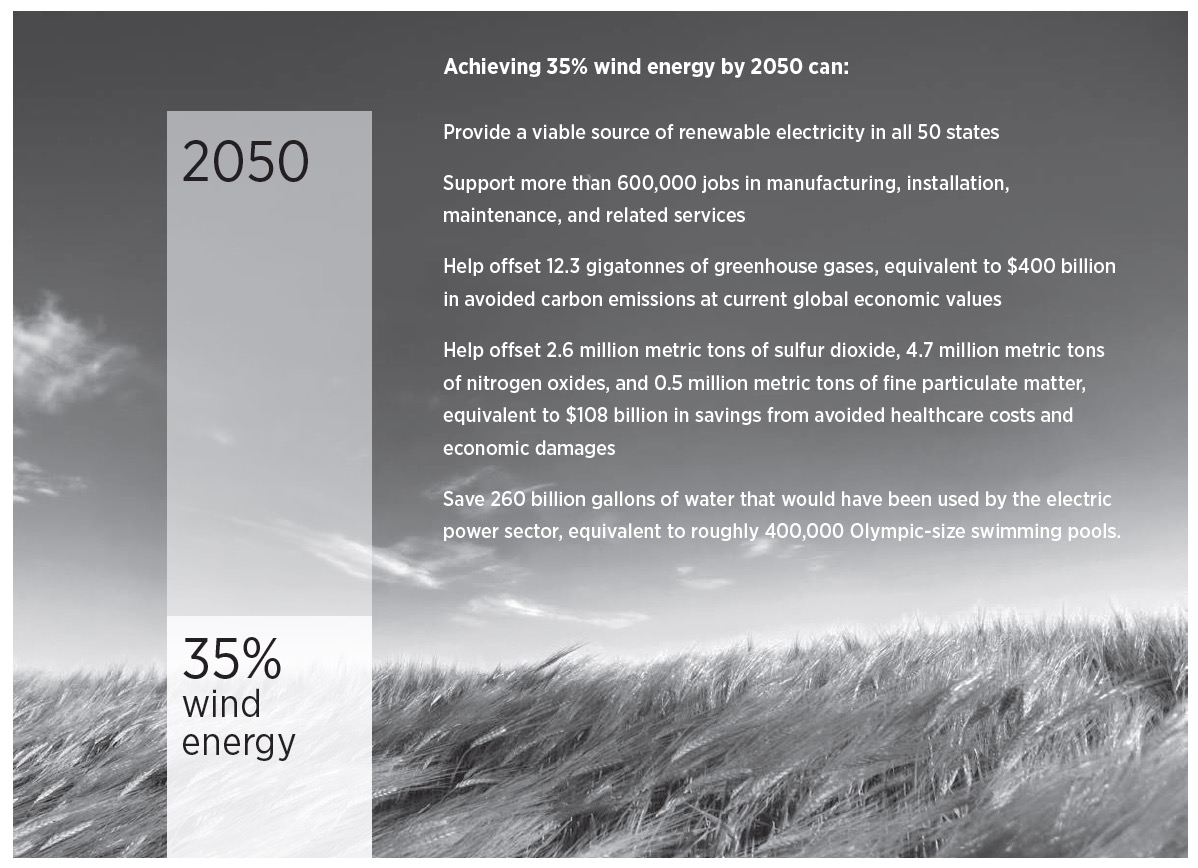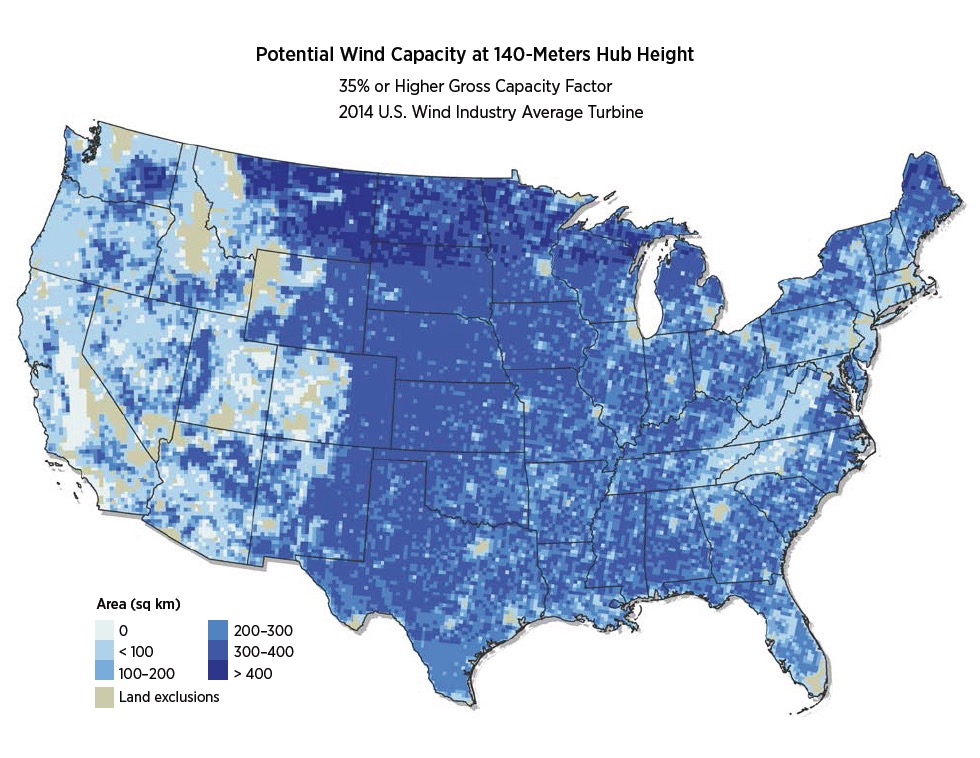UNITED STATES DEPARTMENT OF ENERGY
Powering the Energy Revolution through Wind Evolution
The U.S. Department of Energy (DOE) Wind Program is committed to helping the nation secure cost-competitive sources of renewable energy through the development and deployment of innovative wind power technologies. By investing in improvements to wind plant design, technology development, and operation as well as developing tools to identify the highest quality wind resources, the Wind Program serves as a leader in making wind energy technologies more competitive with traditional sources of energy and a larger part of our nation’s renewable energy portfolio. Greater use of the country’s abundant wind resources for electric power generation will help reduce emissions of greenhouse gases and other air pollutants, diversify the energy supply, provide cost-competitive electricity to key regions across the country, and reduce water usage for power generation. In addition, wind energy deployment will help stimulate the revitalization of key sectors of the economy by investing in infrastructure and creating long-term jobs.
2015 Key Wind Program and National Laboratory Accomplishments
Wind Vision Report Highlights Long-Term Benefits of Investing in America’s Wind Energy Industry
In 2015, DOE published a new Wind Vision report that analyzes the potential for wind power to provide 20% of the nation’s electricity demand by 2030 and 35% by 2050. Wind Vision: A New Era for Wind Power in the United States is the culmination of a 2-year collaborative effort by more than 250 experts from industry, government, and academia. It is one of the many examples of how DOE’s Wind Program provides a nucleus for the research community, bringing together its many diverse stakeholders to achieve a common goal—powering the nation’s energy revolution through wind evolution.
Unlocking Wind Power Across America
In support of the President’s all-of-the above energy strategy, in May 2015, DOE released Enabling Wind Power Nationwide, a report showing how the United States can unlock the vast potential for wind energy deployment in all 50 states—made possible through the next-generation of larger wind turbines.
The new report highlights the potential for technical advancements to unlock wind resources in regions with limited wind deployment today, such as the Southeast. These new regions represent an additional 700,000 square miles—or about one-fifth of the United States—bringing the total area of technical wind potential to 1.8 million square miles.
Technological advancements, such as taller wind turbine towers of 110 and 140 meters and larger rotors—currently under development by DOE and its private sector partners— can more efficiently capture the stronger and more consistent wind resources typically found at greater heights above ground level, compared with the average 80-meter wind turbine towers installed in 39 states today.
Wind Program Executive Summit to Accelerate Technology Transfer
The goal of DOE’s research and development (R&D) efforts is to accelerate the transfer of advanced technologies to industry, ultimately reducing the levelized cost of energy (LCOE). Industry typically invests heavily in shorter-term, component-level R&D but has fewer resources dedicated to longer-term, next-generation technology development. To bridge this gap, DOE prioritizes high-risk, high-reward R&D and invests in government-sponsored projects to drive innovations.
As part of its effort to plan the funding for its future short- and long-term R&D efforts, the Wind Program hosted an Executive Summit in November 2015 that brought together members of the wind industry community and DOE’s national laboratories to focus on investments and technology transfer as they apply to wind energy technology research, development, deployment, and demonstration.
Research and Development
Greater use of the nation’s abundant wind resources for electric power generation will help the nation reduce emissions of greenhouse gases and other air pollutants, diversify its energy supply, provide cost-competitive electricity to key regions across the country, and reduce water usage for power generation. The Wind Program’s research and development activities are leading the nation’s efforts to accelerate the deployment of wind power technologies through improved performance, lower costs, and reduced market barriers.
Market Analysis
The Wind Program’s market analysis activities help increase the use of wind energy in the marketplace by providing strategic data to decision makers and stakeholders interested in rapidly changing electricity markets. Data include market penetration; industry trends; cost, price, and performance trends; policy and market drivers; and future outlooks.
2014 Market Report Highlights Technology Advancement and Industry Growth
According to the 2014 Wind Technologies Market Report produced by LBNL, since the late 1990s, the average nameplate capacity of wind turbines installed in the United States has increased by 172% to 1.9 megawatts (MW) in 2014. Also, the average turbine hub height has increased by 48% to 83 m, and the average rotor diameter has increased by 108% to 99 m. This scaling has enabled wind energy developers to build projects more economically at sites with lower wind speeds.
Performed by: LBNL Principal Investigators: Ryan Wiser, RHWiser@lbl.gov and Mark Bolinger, MABolinger@lbl.gov
Resource Characterization
A crucial factor in the development, siting, and operation of a wind plant is the ability to assess and characterize available wind resources. To achieve this, the Wind Program supports efforts to accurately define, measure, and forecast the nation’s land-based and offshore wind resources.
Download full version (PDF): 2015 Key Wind Program and National Laboratory Accomplishments
About the United States Department of Energy
energy.gov
The mission of the Energy Department is to ensure America’s security and prosperity by addressing its energy, environmental and nuclear challenges through transformative science and technology solutions.
Tags: National Laboratory, U.S. DOE, United States Department of Energy, Wind Energy, Wind Power








 RSS Feed
RSS Feed